Differentiation of Six-meridian Disharmony
TCM further divides exogenous diseases into two types, cold damage (shang han) and febrile disease. There are two diagnostic methods for identifying the disharmonies of exogenous diseases, known as Differentiation of Six-meridian and Differentiation of Four-phase. Physicians like to apply the former method to diagnose the cold damages, while the later method to diagnose the febrile diseases.
The earliest record about the Six-meridian diagnostic method was in the Han Dynasty by Zhang Zhongjing (150~219 AD). He wrote a book named Treatise on Cold-induced and Miscellaneous Diseases, in which specially discussed about different types of exogenous diseases, which became the foundation for diagnosing this kind of diseases in later time.

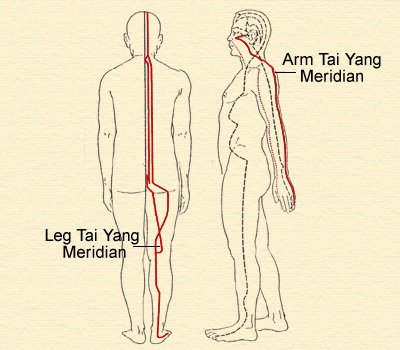 |
1. Tai Yang (small intestine & bladder meridians) Tai yang disease refers to conditions caused by exogenous evils invading the superficial portion of the body, which is also known as syndrome of exterior. |
↓
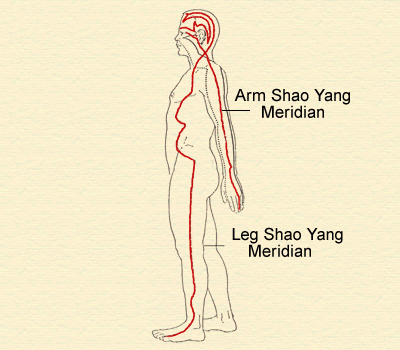 |
2. Shao Yang (gall bladder & triple burner meridians) Shao Yang disease refers to conditions due to unrelieved exterior syndromes that begin to turn towards the interior, but not yet completely reached the interior like in the Yang Ming disease. The pathological changes are neither on the exterior nor in the interior but stay in between, regions like the gall bladder and triple burners are affected. They are known as syndrome of half exterior & half interior. |
↓
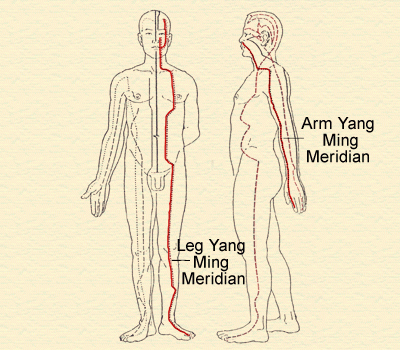 |
3. Yang Ming (stomach & large intestine meridians) Yang Ming disease refers to conditions where the invaded wind and cold evils have converted into fire evil or dryness evil, and they can spread to the internal organs directly, affecting the regions ruled by the Yang Ming meridians. This may also be caused by improper treatment leading to body fluid depletion. The Yang Ming diseases often exhibit a fierce fighting between pathogenic factors and the body’s defense, which indicates the yang qi is still sufficient. |
↓
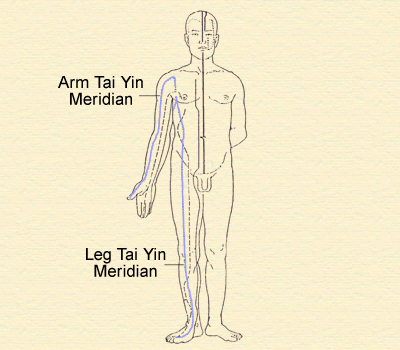 |
4. Tai Yin (lung & spleen meridians) Tai Yin disease refers to conditions involved the interior portion of the body, and present in cold, deficient (xu), or dampness disharmonies. The conditions are often resulted from cold evils attacking the middle burner in a weakened patient, or from delayed treatment of the above three yang meridians diseases. |
↓
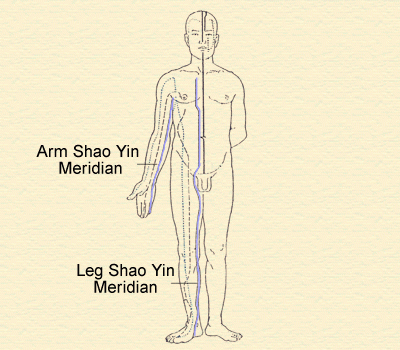 |
5. Shao Yin (heart & kidney meridians) Shao Yin disease refers to pathological changes usually involved the heart and kidneys, which are extremely deficient conditions and characterized by systemic weakness. |
↓
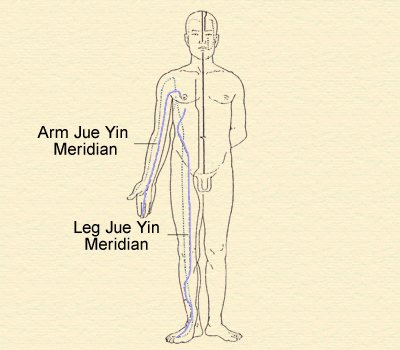 |
Jue Yin (liver & pericardium Meridians) Jue Yin disease indicates the terminal stage of the six-meridian diseases, in which the body’s healthy energy is exhausted. There is a derangement in the yin yang balance, individuals usually show complex and mixed syndromes, such as extreme heat or extreme cold, or alternating cold and heat. |
Disharmonies of the six-meridian diseases
| Diseased meridian & Disharmonies | Presentations | |
| Tai Yang | Exogenous wind | Fever, aversion to wind, headache and sweating. On examination, the pulse is floating and slow. |
| Exterior coldness | Fever, chills, headache, neck stiffness, breathing difficulty, body aching, lumbar and joint pain. On examination, the tongue coating is thin and white, the pulse is floating and tense. | |
| Yang Ming | Interior heat and dryness | High fever, profuse sweating, extreme thirst, flush face and vexation. On examination, the tongue coating is yellow and dry, the pulse is surging and forceful. |
| Excess heat in stomach and intestines | A feverish body, hot flush in the afternoon, constipation, abdominal distention and pain that worsens when pressed, restlessness, even delirium or unconsciousness. On examination, the tongue coating is dry and yellow or yellow with thorns on it; the pulse is deep, excess and forceful. | |
| Shao Yang Half exterior & half interior |
Bitter taste in mouth, dry throat, blurred vision, alternating chills and fever, fullness in chest and under ribs, poor appetite, vexation and nausea. On examination, a white tongue coating and taut pulse is present. | |
| Tai Yin Deficient cold in spleen and stomach |
Abdominal distension with occasional pain and feels better when heating or pressing, vomiting, poor appetite and diarrhea. On examination, the tongue is pale and has a white coating, the pulse is slow and weak. | |
| Shao Yin | Yang deficiency and interior coldness | Aversion to cold, spiritual fatigue, cold limbs, diarrhea, stool containing undigested food, nausea, thirst that prefers hot drinks, profuse and clear urine. On examination, the tongue is pale and has a white coating, the pulse is deep and thready. |
| Yin deficiency with internal heat | Vexation, insomnia, dry mouth, sore throat, abdominal distension, constipation, yellow and scanty urine. On examination, there is a red tongue tip or a deep red tongue with little coating, the pulse is thready and rapid. | |
| Jue Yin | Extreme cold type | Cold limbs, low body temperature and aversion to cold. On examination, there is a pale tongue and an extremely thready, feeble pulse that can hardly be felt. |
| Extreme heat type | Cold limbs, irritability, feverish sensation, thirst and dark yellow urine. On examination, the tongue coating is yellow, and the pulse is rolling. | |


